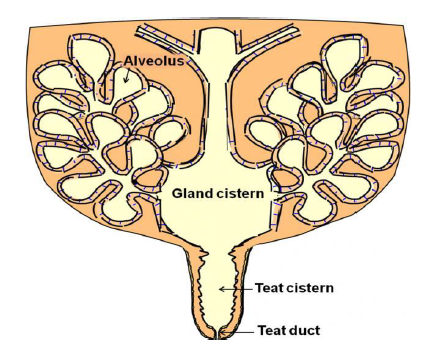Milk secretion involves both intracellular synthesis of milk and subsequent passage of milk from the cytoplasm of the epithelial cells into the alveolar lumen. Milk removal includes passive withdrawal from the cisterns and active ejection from the alveolar lumina. The term lactation refers to the combined processes of milk secretion and removal. Mammogenesis describes the development of the mammary gland. Lactogenesis refers to the initiation of milk secretion, and the term galactopoiesis is used in a general sense to refer to the maintenance of milk secretion and/or the enhancement of established lactation.
The physiology of lactation is intimately intertwined with the physiology of reproductive processes. In the absence of successful lactation (or in the absence of human intervention) the neonate will not survive after birth, even with success of all the complex processes involved in estrous cycles, conception, pregnancy, fetal development, and parturition. The result will be a failure of the reproductive process.

Mammary gland development begins at puberty. It is stimulated by estrogens which stimulate growth of stroma and ductal system plus deposition of fat to give mass to the gland. Additional growth occurs during pregnancy, and the glandular tissue only then becomes completely developed for actual milk production. (stroma refers to connective, functionally supportive framework of a biological cell, tissue or organ)
At pregnancy the tremendous quantities of estrogen secreted by placenta causes the ductal system of the glands to grow and branch. The stroma also increases in quantity and large quantities of fat are laid down in stroma.Growth hormone, prolactin, adrenal glucocorticoids and insulin also play some role in this growth.
Final development of the gland into milk-secreting organ also requires the additional action of progesterone. Progesterone causes development of secretory characteristics of the cells of alveoli.
The specific effect of both progesterone and estrogen during pregnancy is to inhibit the actual secretion of milk. Therefore although prolactin also increases steadily during pregnancy, the animal is unable to produce milk until after pregnancy. Thus immediately after birth, the sudden loss of both estrogen and progesterone secretio by the placenta now allows the lactogenic effect of the prolactin from the mothers pituitary gland to assume its natural milk-promoting role. Growth hormone, cortisol and parathyroid hormone also aid in milk secretion by providing the amino acids, fatty acids and calcium required for milk formation.
After birth, prolactin secretion returns during the next few weeks to the non-pregnant level, but nervous signals from teats to hypothalamus during milking/suckling are responsible for causing a prolactin surge which in turn acts on the mammary gland to provide milk.
marto answered the question on
April 16, 2019 at 11:57